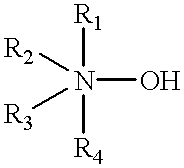Process for the preparation of high activity carbon monoxide hydrogenation catalysts; the catalyst composition, use of the catalysts for conducting such reactions, and the products of such reactions
- Summary
- Abstract
- Description
- Claims
- Application Information
AI Technical Summary
Benefits of technology
Problems solved by technology
Method used
Image
Examples
Embodiment Construction
Preparation of Co--Pt / SiO.sub.2 Catalyst Precursors
(1) Silica gel, (KCKG #4 manufactured by Salavant Petro Chemical Catalyst Factory of Salavant Russia), 2-4 mm average diameter, was ground and sieved to obtain a fraction constituted of particles of 0.106-0.250 mm average diameter. The fraction of sieved silica gel was calcined in flowing air at 450.degree. C. for 5 hours, and then cooled.
(2) To form a cobalt-silica composite, a solution of 5.18 gms of Co(NO.sub.3).sub.2 *6H.sub.2 O in 15 ml distilled water was prepared, and 21 ml (8.38 gm) of the calcined silica support was added thereto while the solution was vigorously stirred. The cobalt impregnated support was then dried on a steam bath. The dried catalyst precursor was then placed in a quartz tube and calcined in flowing air at 450.degree. C. for 1 hour. The impregnated cobalt catalyst precursor, on a dry basis, contained nominally 10 wt. % cobalt.
(3) Next, to form a cobalt-platinum / silica composite, a solution of 0.0866 gm of...
PUM
| Property | Measurement | Unit |
|---|---|---|
| Fraction | aaaaa | aaaaa |
| Fraction | aaaaa | aaaaa |
| Fraction | aaaaa | aaaaa |
Abstract
Description
Claims
Application Information
 Login to View More
Login to View More - R&D
- Intellectual Property
- Life Sciences
- Materials
- Tech Scout
- Unparalleled Data Quality
- Higher Quality Content
- 60% Fewer Hallucinations
Browse by: Latest US Patents, China's latest patents, Technical Efficacy Thesaurus, Application Domain, Technology Topic, Popular Technical Reports.
© 2025 PatSnap. All rights reserved.Legal|Privacy policy|Modern Slavery Act Transparency Statement|Sitemap|About US| Contact US: help@patsnap.com

